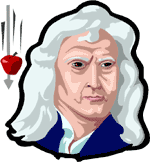

For
centuries scientists have been wrestling with the problem of how much
does the world weigh. Newton tried it. He was said to be the first, but
he wasn't the last.
Now a team in Seattle at the University of Washington believe they have
the answer.
According to them the earth weighs 5,972 billion billion tons.
They've also had a go at estimating the sun's weight. 1,988 billion billion
billion tons
More about the
future.
The development wing of Siemens, known as Roke Manor Research, has released
the following predictions about the next ten years. The experts there
have chosen to tell
the world that we shall be seeing:
- Robot controlled taxis
- Factories in space
- Journalists with cameras planted in their eyes
- The end of school books
- Fingerprint or retina scans at banks
- Shop tills will deduct the cost of purchases from telephone-based bank accounts
- Signing documents will be 'old school'.
- The wave of resistance to robot drivers will diminish in time...
According to the latest research, as good as red wine is supposed to be for the heart, beer is even better. The secret lies in the high levels of vitamin B found in beer, apparently. These prevent the build-up up in the body of a chemical known to cause heart disease, homocystene. These findings, published in the Lancet, seem to suggest that drinking up to three quarters of a pint of beer every day was found to increase vitamin B in blood plasma by 30%. Researchers in Holland, at the TNO Nutrition and Food research Institute studied 11 healthy men aged between 44 and 59 over a period of 12 weeks. These men drank beer, red wine, and Dutch gin. Among the wine and gin drinkers, the increase in homostycene levels - 8 and 9 per cent resepctively - would be the equivalent of a 20-30 per cent increase in the risk of heart disease. Only the beer kept down the homocystene levels in all cases. So, it's beer all the way.
An independent report by 12 experts has declared that mobile phones do not pose a danger to health. The study shows that emissions from the brain heat the body by only one tenth of one degree. The body's normal temperature varies in any case by one degree every day. Repeated claims that 'microwave' emissions were 'cooking people's brains', and that the radiation from cell phones can cause tumours and memory loss were unfounded according to this British Commission, known as the Stewart Enquiry. But the 12 person panel will still be calling for tighter controls, and to urge for the funding of more research. Recent tests showed that some models of Motorola, Nokia, Sony and Ericsson had low radiation specific absorption rates (SAR's), and certain phones made by Philips, Bosch and Siemens had high SAR's
People come from
all over the world to see it, to sit under it, to jump under it while
the camera snaps them defying what the apple tree is famous for. It is
Sir Isaac Newton's apple tree, and the belief is that the great man was
sitting under it when an apple fell on his noggin - or just missed him.
Either way the the event is said to have made
Newton 'think of gravity extending to the orb of the Moon'.
Actually the apple didn't quite fall on his head. According
to his first biographer, Newton was in fact indoors. He was eating
his dinner and reading Galileo; happening to
glance out of the window, he saw an apple teeter under its branch, and
fall.
Incidentally, in 1820, the tree itself fell foul of gravity. It blew down.
Souvenir hunters gathered the wood. But it was a large tree, and a nine
foot length of its trunk was left on the ground.
It sprouted, and a new tree grew, tall and proud. Botanists have declared
this to be possible.
Neutrinos are
elusive particles which travel at the speed of light and hardly interact
with matter. The great physicist Enrico Fermi gave them the name 'neutrinos
- 'liitle neutral ones'.
A neutrino could pass through a wall of lead so thick that it stretched
from Earth to Jupiter.
Now scientists are collaborating to study neutrions that zoom through
the earth. They will start modestly. One beam of particles will go between
two locations in Japan, another will be sent from Illinois to Minnesota,
just 450 miles. A third will go from Geneva, via Mont Blanc, Alessandria,
Florence, and Assisi, before emerging in the Gran Sasso mountains.
The latest hope, though, is to send particles from Oxfordshire to Japan,
a distance of 5,300 miles.
A major question concerning neutrinos is, how much if anything do they
weigh? Two years ago, a team of 100 scientists reported evidence of mass
in them, which might suggest that they somehow change their identity as
they travel.
Neutrinos are ghostly relics of creation, and they could help scientists
to understand why there seems to be so much more matter than antimatter
in the univesre. Both were made in equal quantities 12 billion years ago
when the universe began.
A new DNA test
will help Black Americans to trace their roots in Africa. The test, which
should be available this summer, could uncover links between the genes
of black people in America and a database of 2,000 samples taken from
40 separate ethnic groups in west Africa - the region from which most
slaves were taken.
Geneticists at Howard University in Washington, where the tests are being
offered, have predicted that many black Americans will also find genetic
roots in England and throughout Europe.
As the Sydney Olympics
approach, Brian Welsby will have cause to be as nervous as his athletes.
His dietary ideas are on trial again, and now, because he is hoping that
the less fit citizens of the world will take to the dietary formulae that
he has been using on athletes for some time.
Welsby's most dramatic result so far in sport has been with the French
cyclist, Marion Clignet, who suffered from a progressive arthritic condition.
Ms Clignet had tried everything,
when, as a last resort, she saw Welsby. he gave her a compound he calls
Breakthrough. Last October Marion Clignet became world champion in the
3,000 metres pursuit.
Breakthrough has also been used in the Bristol Cancer Hospital, and -
in the Netherlands- hospital reports have come in to the effect that the
only children with leukemia who have kept their hair and been able to
return to school have been those taking Breakthrough.
Welsby, a trained chemist and biochemist, works from the assumption that
organophosphate fertilisers have sucked trace elements out of the soil
and that however well we eat we cannot obtain the nutrients that we need.
About 4,000 enzymes regulate the body, and as elements have disappeared
from the soil and from plants, those enzymes which require selenium, chromium,
zinc, manganese and silver have effectively shut down. Even top athletes
who look after themselves are running on three cylinders, as
Welsby puts it.
Welsby believes the secret of his compound lies in the peptide bonding.
For vitamins to be taken up by the body, they have to have the right bonding
to stay there. The vitamin is the key and as long as it has the peptide
bond it can find the lock in the body. With synthetic or inorganic vitamins
and minerals you have to hope that you have eaten the right food so that
the peptide bond has been formed. Most often, it hasn't.
A programme of Welsby's Breakthrough costs a few hundred English pounds.
It's expensive, but he is working on modifications to combat Crohn's disease,
irritable bowel disease and mental illness.
And there are also those athletes on their way to Sydney, who could make
Brian Welsby's name.






